Accident Prevention Analysis: Exploring the Intellectual Structure of a Research Field
Abstract
1. Introduction
2. Materials and Methods
2.1. Sample Collection and Cleaning
2.2. Method
3. Result and Discussion
3.1. Time Distribution of the Literature
3.1.1. Time Distribution of World Literature
3.1.2. Time Distribution of National Literature
3.2. Spatial Distribution Map of the Literature
3.2.1. Country/Region Distribution
3.2.2. Disciplinary Distribution of the Literature
3.2.3. Institutional Distribution of Literature
3.2.4. Journal Distribution
3.3. Research Knowledge Base
3.3.1. The Literature Co-Citation Analysis
3.3.2. The Journal Co-Citation Analysis
3.3.3. The Co-Authorship Analysis
3.4. Research Hotspots and Frontier Analysis
3.4.1. Keyword Co-Occurrence Analysis
3.4.2. High-Cited Literature Analysis
3.4.3. Combing Evolution Path
3.4.4. Research Frontier Identification
4. Conclusions
Author Contributions
Funding
Institutional Review Board Statement
Informed Consent Statement
Data Availability Statement
Conflicts of Interest
References
- Bernatik, A.; Kocurkova, L.; Jørgensen, K. Prevention of Accidents at Work. In Prevention of Accidents at Work, Proceedings of the 9th International Conference on the Prevention of Accidents at Work (WOS 2017), Prague, Czech Republic, 3–6 October 2017; CRC Press: Boca Raton, FL, USA, 2017; pp. 1–8. [Google Scholar]
- Wang, B.; Wu, C.; Huang, L.; Kang, L.; Lei, Y. Safety science as a new discipline in China. Saf. Sci. 2020, 121, 201–214. [Google Scholar] [CrossRef]
- Hirano, M.; Yonomoto, T.; Ishigaki, M.; Watanabe, N.; Maruyama, Y.; Sibamoto, Y.; Watanabe, T.; Moriyama, K. Insights from review and analysis of the Fukushima Dai-ichi accident. J. Nucl. Sci. Technol. 2012, 49, 1–17. [Google Scholar] [CrossRef]
- Hu, H. An explosion at the plant of the German chemical giant BASF. China’s Agric. Mater. 2016, 12, 40. [Google Scholar]
- Wang, B.; Wu, C.; Huang, L. Data literacy for safety professionals in safety management: A theoretical perspective on basic questions and answers. Saf. Sci. 2019, 117, 15–22. [Google Scholar] [CrossRef]
- Chao, W.; Yang, M. The research status and prospect of the whole scientific principle. In Proceedings of the the 27th National Academic Conference of Safety Engineering in Colleges and Universities and the 9th National Education Seminar for Master of Engineering in Safety Engineering, Langfang, China, 23–25 October 2015; pp. 7–15. [Google Scholar]
- Minhad, K.N.; Ali, S.H.M.; Reaz, M.B. Happy-anger emotions classifications from electrocardiogram signal for automobile driving safety and awareness. J. Transp. Health 2017, 7, 75–89. [Google Scholar] [CrossRef]
- Liang, H.K.; Lin, K.Y.; Zhang, S.J. Understanding the Social Contagion Effect of Safety Violations within a Construction Crew: A Hybrid Approach Using System Dynamics and Agent-Based Modeling. Int. J. Environ. Res. Public Health 2018, 15, 2696. [Google Scholar] [CrossRef]
- DeJoy, D.M. Behavior change versus culture change: Divergent approaches to managing workplace safety. Saf. Sci. 2005, 43, 105–129. [Google Scholar] [CrossRef]
- Hanninen, M. Bayesian networks for maritime traffic accident prevention: Benefits and challenges. Accid. Anal. Prev. 2014, 73, 305–312. [Google Scholar] [CrossRef]
- Jo, J. Vision-based method for detecting driver drowsiness and distraction in driver monitoring system. Opt. Eng. 2011, 50, 127202. [Google Scholar] [CrossRef]
- Yang, K.; Ahn, C.R.; Vuran, M.C.; Aria, S.S. Semi-supervised near-miss fall detection for ironworkers with a wearable inertial measurement unit. Autom. Constr. 2016, 68, 194–202. [Google Scholar] [CrossRef]
- Wang, B.; Wu, C.; Huang, L.; Zhang, L.B.; Kang, L.G.; Gao, K.X. Prevention and control of major accidents (MAs) and particularly serious accidents (PSAs) in the industrial domain in China: Current status, recent efforts and future prospects. Process Saf. Environ. Prot. 2018, 117, 254–266. [Google Scholar] [CrossRef]
- Liu, H.; Chen, H.L.; Hong, R.; Liu, H.G.; You, W.J. Mapping knowledge structure and research trends of emergency evacuation studies. Saf. Sci. 2020, 121, 348–361. [Google Scholar] [CrossRef]
- Debrabant, B.; Halekoh, U.; Bonat, W.H.; Hansen, D.L.; Hjelmborg, J.; Lauritsen, J. Identifying traffic accident black spots with Poisson-Tweedie models. Accid. Anal. Prev. 2018, 111, 147–154. [Google Scholar] [CrossRef]
- Zhou, L.; Fu, G.; Xue, Y. Human and organizational factors in Chinese hazardous chemical accidents: A case study of the ‘8.12’ Tianjin Port fire and explosion using the HFACS-HC. Int. J. Occup. Saf. Ergon. 2018, 24, 329–340. [Google Scholar] [CrossRef] [PubMed]
- Ikpe, E.; Hammon, F.; Oloke, D. Cost-Benefit Analysis for Accident Prevention in Construction Projects. J. Constr. Eng. Manag. 2012, 138, 991–998. [Google Scholar] [CrossRef]
- Martin, J.E.; Rivas, T.; Matias, J.M.; Taboada, J.; Arguelles, A. A Bayesian network analysis of workplace accidents caused by falls from a height. Saf. Sci. 2009, 47, 206–214. [Google Scholar] [CrossRef]
- Li, J.; Goerlandt, F.; Reniers, G. An overview of scientometric mapping for the safety science community: Methods, tools, and framework. Saf. Sci. 2021, 134, 105093. [Google Scholar] [CrossRef]
- Cobo, M.J.; Chiclana, F.; Collop, A.; de Ona, J.; Herrera-Viedma, E. A Bibliometric Analysis of the Intelligent Transportation Systems Research Based on Science Mapping. IEEE Trans. Intell. Transp. Syst. 2014, 15, 901–908. [Google Scholar] [CrossRef]
- Liang, H.; Zhang, S.; Su, Y. The structure and emerging trends of construction safety management research: A bibliometric review. Int. J. Occup. Saf. Ergon. 2020, 26, 469–488. [Google Scholar] [CrossRef]
- Lopez-Munoz, F.; Alamo, C.; Rubio, G.; Garcia-Garcia, P.; Martin-Agueda, B.; Cuenca, E. Bibliometric analysis of biomedical publications on SSRI during 1980–2000. Depress. Anxiety 2003, 18, 95–103. [Google Scholar] [CrossRef]
- Garg, K.C.; Kumar, S.; Madhavi, Y.; Bahl, M. Bibliometrics of global malaria vaccine research. Health Inf. Libr. J. 2009, 26, 22–31. [Google Scholar] [CrossRef] [PubMed]
- Yanagisawa, K.; Ito, K.; Katsuki, C.; Kawashima, K.; Shirabe, M. An outcome of nuclear safety research in JAERI: Case study for LOCA. Scientometrics 2010, 84, 563–573. [Google Scholar] [CrossRef]
- Silva, J.A.; Menegon, N.L.; de Carvalho, M.M. Human reliability and ergonomics: A literature review from 1963 to 2011. Work 2012, 41 (Suppl. S1), 3252–3259. [Google Scholar] [CrossRef]
- Zaharia, A.; Popescu, G.; Vreja, L.O. Energy Scientific Production in the Context of the Green Development Models. Econ. Comput. Econ. Cybern. Stud. Res. 2016, 50, 151–168. [Google Scholar]
- Lang, Z.H.; Liu, H.; Meng, N.; Wang, H.N.; Wang, H.; Kong, F.Y. Mapping the knowledge domains of research on fire safety—an informetrics analysis. Tunn. Undergr. Space Technol. 2021, 108, 103676. [Google Scholar] [CrossRef]
- van Nunen, K.; Li, J.; Reniers, G.; Ponnet, K. Bibliometric analysis of safety culture research. Saf. Sci. 2018, 108, 248–258. [Google Scholar] [CrossRef]
- Xue, J.; Reniers, G.; Li, J.; Yang, M.; Wu, C.Z.; van Gelder, P. A Bibliometric and Visualized Overview for the Evolution of Process Safety and Environmental Protection. Int. J. Environ. Res. Public Health 2021, 18, 5985. [Google Scholar] [CrossRef]
- Gou, X.Q.; Liu, H.; Qiang, Y.J.; Lang, Z.H.; Wang, H.N.; Ye, D.; Wang, Z.W.; Wang, H. In-depth analysis on safety and security research based on system dynamics: A bibliometric mapping approach-based study. Saf. Sci. 2022, 147, 105617. [Google Scholar] [CrossRef]
- Goerlandt, F.; Li, J.; Reniers, G. Virtual Special Issue: Mapping Safety Science—Reviewing Safety Research. Saf. Sci. 2021, 140, 105278. [Google Scholar] [CrossRef]
- Broadus, R.N. Toward a definition of “bibliometrics”. Scientometrics 1987, 12, 373–379. [Google Scholar] [CrossRef]
- Zou, X.; Vu, H.L.; Huang, H. Fifty Years of Accident Analysis & Prevention: A Bibliometric and Scientometric Overview. Accid. Anal. Prev. 2020, 144, 105568. [Google Scholar] [CrossRef] [PubMed]
- Lang, Z.H.; Wang, D.G.; Liu, H.; Gou, X.Q. Mapping the knowledge domains of research on corrosion of petrochemical equipment: An informetrics analysis-based study. Eng. Fail. Anal. 2021, 129, 105716. [Google Scholar] [CrossRef]
- Heffter, W. Accident prevention and industrial hygiene. Z. Des. Ver. Dtsch. Ing. 1902, 46, 853–855. [Google Scholar]
- Wachter, J.K.; Yorio, P.L. A system of safety management practices and worker engagement for reducing and preventing accidents: An empirical and theoretical investigation. Accid. Anal. Prev. 2014, 68, 117–130. [Google Scholar] [CrossRef]
- Loosemore, M. Psychology of accident prevention in the construction industry. J. Manag. Eng. 1998, 14, 50–56. [Google Scholar] [CrossRef]
- Aldieri, L.; Kotsemir, M.; Vinci, C.P. The impact of research collaboration on academic performance: An empirical analysis for some European countries. Socio-Econ. Plan. Sci. 2018, 62, 13–30. [Google Scholar] [CrossRef]
- Yang, Y.F.; Reniers, G.; Chen, G.H.; Goerlandt, F. A bibliometric review of laboratory safety in universities. Saf. Sci. 2019, 120, 14–24. [Google Scholar] [CrossRef]
- Jiao, T.T.; Zhuang, X.L.; He, H.Y.; Zhao, L.H.; Li, C.S.; Chen, H.N.; Zhang, S.J. An ionic liquid extraction process for the separation of indole from wash oil. Green Chem. 2015, 17, 3783–3790. [Google Scholar] [CrossRef]
- Nordfjærn, T.; Rundmo, T. Personality, risk cognitions and motivation related to demand of risk mitigation in transport among Norwegians. Saf. Sci. 2015, 73, 15–22. [Google Scholar] [CrossRef]
- Liu, H.; Hong, R.; Xiang, C.L.; Lv, C.; Li, H.H. Visualization and analysis of mapping knowledge domains for spontaneous combustion studies. Fuel 2020, 262, 116598. [Google Scholar] [CrossRef]
- Chen, C. CiteSpace II: Detecting and visualizing emerging trends and transient patterns in scientific literature. J. Am. Soc. Inf. Sci. Technol. 2006, 57, 359–377. [Google Scholar] [CrossRef]
- Cole, T.J.; Bellizzi, M.C.; Flegal, K.M.; Dietz, W.H. Establishing a standard definition for child overweight and obesity worldwide: International survey. BMJ 2000, 320, 1240–1243. [Google Scholar] [CrossRef] [PubMed]
- Rasmussen, J. Risk management in a dynamic society: A modelling problem. Saf. Sci. 1997, 27, 183–213. [Google Scholar] [CrossRef]
- Reason, J.; Manstead, A.; Stradling, S.; Baxter, J.; Campbell, K. Errors and violations on the roads: A real distinction? Ergonomics 1990, 33, 1315–1332. [Google Scholar] [CrossRef] [PubMed]
- Leveson, N. A new accident model for engineering safer systems. Saf. Sci. 2004, 42, 237–270. [Google Scholar] [CrossRef]
- Reason, J. Managing the Risks of Organizational Accidents; Ashgate: Farnham, UK, 1997. [Google Scholar]
- Hopkins, A. Was Three Mile Island a ‘Normal Accident’? J. Contingencies Crisis Manag. 2001, 9, 65–72. [Google Scholar] [CrossRef]
- Abdelhamid, T.S.; Everett, J.G. Identifying Root Causes of Construction Accidents. J. Constr. Eng. Manag. 2000, 126, 52–60. [Google Scholar] [CrossRef]
- Haslam, R.A.; Hide, S.A.; Gibb, A.G.; Gyi, D.E.; Pavitt, T.; Atkinson, S.; Duff, A.R. Contributing factors in construction accidents. Appl. Ergon. 2005, 36, 401–415. [Google Scholar] [CrossRef]
- Pinto, A.; Nunes, I.L.; Ribeiro, R.A. Occupational risk assessment in construction industry—Overview and reflection. Saf. Sci. 2011, 49, 616–624. [Google Scholar] [CrossRef]
- Tam, C.M.; Zeng, S.X.; Deng, Z.M. Identifying elements of poor construction safety management in China. Saf. Sci. 2004, 42, 569–586. [Google Scholar] [CrossRef]
- Peden, M.; Scurfield, R.; Sleet, D.; Mohan, D.; Hyder, A.A.; Jarawan, E.; Mathers, C. World Report on Road Traffic Injury Prevention; World Health Organization: Geneva, Switzerland, 2004. [Google Scholar]
- World Health Organization. Global Status Report on Road Safety. Injury Prev. 2015, 15, 286. [Google Scholar]
- Guldenmund, F.W. The nature of safety culture: A review of theory and research. Saf. Sci. 2000, 34, 215–257. [Google Scholar] [CrossRef]
- Zohar, D. Safety climate in industrial organizations: Theoretical and applied implications. J. Appl. Psychol. 1980, 65, 96–102. [Google Scholar] [CrossRef] [PubMed]
- Neal, A.; Griffin, M.A.; Hart, P.M. The impact of organizational climate on safety climate and individual behavior. Saf. Sci. 2000, 34, 99–109. [Google Scholar] [CrossRef]
- Suraji, A.; Duff, A.R.; Peckitt, S.J. Development of Causal Model of Construction Accident Causation. J. Constr. Eng. Manag. 2001, 127, 337–344. [Google Scholar] [CrossRef]
- Hughes, B.P.; Newstead, S.; Anund, A.; Shu, C.C.; Falkmer, T. A review of models relevant to road safety. Accid. Anal. Prev. 2015, 74, 250–270. [Google Scholar] [CrossRef]
- Flin, R.; Mearns, K.; O’Connor, P.; Bryden, R. Measuring safety climate: Identifying the common features. Saf. Sci. 2000, 34, 177–192. [Google Scholar] [CrossRef]
- Buwalda, J.; Schouwenburg, P.F.; Blank, L.E.; Merks, J.H.; Copper, M.P.; Strackee, S.D.; Voute, P.A.; Caron, H.N. A novel local treatment strategy for advanced stage head and neck rhabdomyosarcomas in children: Results of the AMORE protocol. Eur. J. Cancer 2003, 39, 1594–1602. [Google Scholar] [CrossRef]
- Yang, Y.; Chen, G.; Reniers, G.; Goerlandt, F. A bibliometric analysis of process safety research in China: Understanding safety research progress as a basis for making China’s chemical industry more sustainable. J. Clean. Prod. 2020, 263, 121433. [Google Scholar] [CrossRef]
- Kambas, A.; Antoniou, P.; Xanthi, G.; Heikenfeld, R.; Taxildaris, K.; Godolias, G. Accident prevention through development of coordination in kindergarten children. Dtsch. Z. Sportmed. 2004, 55, 44–47. [Google Scholar]
- Ma, Z.L.; Shao, C.F.; Zhang, S.R. Characteristics of traffic accidents in Chinese freeway tunnels. Tunn. Undergr. Space Technol. 2009, 24, 350–355. [Google Scholar] [CrossRef]
- Favaro, F.M.; Saleh, J.H. Toward risk assessment 2.0: Safety supervisory control and model-based hazard monitoring for risk-informed safety interventions. Reliab. Eng. Syst. Saf. 2016, 152, 316–330. [Google Scholar] [CrossRef][Green Version]
- Uzun, I.M.; Cebi, S. A novel approach for classification of occupational health and safety measures based on their effectiveness by using fuzzy Kano model. J. Intell. Fuzzy Syst. 2020, 38, 589–600. [Google Scholar] [CrossRef]
- Kaskutas, V.K.; Dale, A.M.; Lipscomb, H.J.; Evanoff, B.A. Development of the St. Louis audit of fall risks at residential construction sites. Int. J. Occup. Environ. Health 2008, 14, 243–249. [Google Scholar] [CrossRef]
- Sonnemans, P.J.M.; Körvers, P.M.W.; Pasman, H.J. Accidents in “normal” operation—Can you see them coming? J. Loss Prev. Process Ind. 2010, 23, 351–366. [Google Scholar] [CrossRef]
- Cao, Q.G.; Jia, B.; Chen, H.; Sun, Q.H.; Lu, X.L. Multi-level control technology of coal mine accident risk. Disaster Adv. 2013, 6, 37–44. [Google Scholar]
- Brahm, F.; Singer, M. Is more engaging safety training always better in reducing accidents? Evidence of self-selection from Chilean panel data. J. Saf. Res. 2013, 47, 85–92. [Google Scholar] [CrossRef]
- Scott, J.G.; Shore, E.; Brown, C.; Harris, C.; Rosen, M.A. Highlights from occupational safety and health continuing education needs assessment. Am. J. Ind. Med. 2019, 62, 901–907. [Google Scholar] [CrossRef]
- Shannon, H.S.; Robson, L.S.; Sale, J.E. Creating safer and healthier workplaces: Role of organizational factors and job characteristics. Am. J. Ind. Med. 2001, 40, 319–334. [Google Scholar] [CrossRef]
- Hong, R.; Liu, H.; Xiang, C.L.; Song, Y.M.; Lv, C. Visualization and analysis of mapping knowledge domain of oxidation studies of sulfide ores. Environ. Sci. Pollut. Res. 2020, 27, 5809–5824. [Google Scholar] [CrossRef]
- Hurjui, I.; Hurjui, M.C. Health system management. Rom. J. Leg. Med. 2019, 27, 325–328. [Google Scholar] [CrossRef]
- Shults, R.A.; Elder, R.W.; Sleet, D.A.; Nichols, J.L.; Alao, M.O.; Carande-Kulis, V.G.; Zaza, S.; Sosin, D.M.; Thompson, R.S. Reviews of evidence regarding interventions to reduce alcohol-impaired driving. Am. J. Prev. Med. 2001, 21, 66–88. [Google Scholar] [CrossRef]
- Lisbona, D.; Snee, T. A review of hazards associated with primary lithium and lithium-ion batteries. Process Saf. Environ. Prot. 2011, 89, 434–442. [Google Scholar] [CrossRef]
- Faber, M.J.; Bosscher, R.J.; Paw, M.; van Wieringen, P.C. Effects of exercise programs on falls and mobility in frail and pre-frail older adults: A multicenter randomized controlled trial. Arch. Phys. Med. Rehabil. 2006, 87, 885–896. [Google Scholar] [CrossRef]
- Colver, A.; Fairhurst, C.; Pharoah, P.O.D. Cerebral palsy. Lancet 2014, 383, 1240–1249. [Google Scholar] [CrossRef]
- Rennie, L.; Court-Brown, C.M.; Mok, J.Y.Q.; Beattie, T.F. The epidemiology of fractures in children. Injury 2007, 38, 913–922. [Google Scholar] [CrossRef]
- Seo, D.C.; Torabi, M.R.; Blair, E.H.; Ellis, N.T. A cross-validation of safety climate scale using confirmatory factor analytic approach. J. Saf. Res. 2004, 35, 427–445. [Google Scholar] [CrossRef]
- Constantinou, E.; Panayiotou, G.; Konstantinou, N.; Loutsiou-Ladd, A.; Kapardis, A. Risky and aggressive driving in young adults: Personality matters. Accid. Anal. Prev. 2011, 43, 1323–1331. [Google Scholar] [CrossRef]
- Ivshina, I.B.; Kuyukina, M.S.; Krivoruchko, A.V.; Elkin, A.A.; Makarov, S.O.; Cunningham, C.J.; Peshkur, T.A.; Atlas, R.M.; Philp, J.C. Oil spill problems and sustainable response strategies through new technologies. Environ. Sci.-Processes Impacts 2015, 17, 1201–1219. [Google Scholar] [CrossRef]
- Mitropoulos, P.; Abdelhamid, T.S.; Howell, G.A. Systems model of construction accident causation. J. Constr. Eng. Manag. 2005, 131, 816–825. [Google Scholar] [CrossRef]
- Rundmo, T. Associations between risk perception and safety. Saf. Sci. 1996, 24, 197–209. [Google Scholar] [CrossRef]
- Holzapfel, L.; Chevret, S.; Madinier, G.; Ohen, F.; Demingeon, G.; Coupry, A.; Chaudet, M. Influence of Long-Term Orotracheal or Nasotracheal Intubation on Nosocomial Maxillary Sinusitis and Pneumonia—Results of A Prospective, Randomized, Clinical-Trial. Crit. Care Med. 1993, 21, 1132–1138. [Google Scholar] [CrossRef] [PubMed]
- Uehli, K.; Mehta, A.J.; Miedinger, D.; Hug, K.; Schindler, C.; Holsboer-Trachsler, E.; Leuppi, J.D.; Kunzli, N. Sleep problems and work injuries: A systematic review and meta-analysis. Sleep Med. Rev. 2014, 18, 61–73. [Google Scholar] [CrossRef] [PubMed]
- Saleh, J.H.; Cummings, A.M. Safety in the mining industry and the unfinished legacy of mining accidents: Safety levers and defense-in-depth for addressing mining hazards. Saf. Sci. 2011, 49, 764–777. [Google Scholar] [CrossRef]
- Aires, M.D.M.; Gamez, M.C.R.; Gibb, A. Prevention through design: The effect of European Directives on construction workplace accidents. Saf. Sci. 2010, 48, 248–258. [Google Scholar] [CrossRef]
- Bakolas, E.; Saleh, J.H. Augmenting defense-in-depth with the concepts of observability and diagnosability from Control Theory and Discrete Event Systems. Reliab. Eng. Syst. Saf. 2011, 96, 184–193. [Google Scholar] [CrossRef]
- Saleh, J.H.; Saltmarsh, E.A.; Favarò, F.M.; Brevault, L. Accident precursors, near misses, and warning signs: Critical review and formal definitions within the framework of Discrete Event Systems. Reliab. Eng. Syst. Saf. 2013, 114, 148–154. [Google Scholar] [CrossRef]
- Saleh, J.H.; Haga, R.A.; Favarò, F.M.; Bakolas, E. Texas City refinery accident: Case study in breakdown of defense-in-depth and violation of the safety–diagnosability principle in design. Eng. Fail. Anal. 2014, 36, 121–133. [Google Scholar] [CrossRef]
- Saleh, J.H.; Marais, K.B.; Favaró, F.M. System safety principles: A multidisciplinary engineering perspective. J. Loss Prev. Process Ind. 2014, 29, 283–294. [Google Scholar] [CrossRef]
- Cowlagi, R.V.; Saleh, J.H. Coordinability and consistency in accident causation and prevention: Formal system theoretic concepts for safety in multilevel systems. Risk Anal. 2013, 33, 420–433. [Google Scholar] [CrossRef]
- Brody, B.; Létourneau, Y.; Poirier, A. An indirect cost theory of work accident prevention. J. Occup. Accid. 1990, 13, 255–270. [Google Scholar] [CrossRef]
- Guastello, S.J. Do we really know how well our occupational accident prevention programs work? Saf. Sci. 1993, 16, 445–463. [Google Scholar] [CrossRef]
- Hinze, J.; Pedersen, C.; Fredley, J. Identifying Root Causes of Construction Injuries. J. Constr. Eng. Manag. 1998, 124, 67–71. [Google Scholar] [CrossRef]
- Krause, T.R.; Seymour, K.J.; Sloat, K.C.M. Long-term evaluation of a behavior-based method for improving safety performance: A meta-analysis of 73 interrupted time-series replications. Saf. Sci. 1999, 32, 1–18. [Google Scholar] [CrossRef]
- Hinze, J.; Huang, X.; Terry, L. The Nature of Struck-by Accidents. J. Constr. Eng. Manag. 2005, 131, 262–268. [Google Scholar] [CrossRef]
- Lund, J.; Aarø, L.E. Accident prevention. Presentation of a model placing emphasis on human, structural and cultural factors. Saf. Sci. 2004, 42, 271–324. [Google Scholar] [CrossRef]
- Shapira, A.; Lyachin, B. Identification and Analysis of Factors Affecting Safety on Construction Sites with Tower Cranes. J. Constr. Eng. Manag. 2009, 135, 24–33. [Google Scholar] [CrossRef]
- Fogarty, G.J.; Shaw, A. Safety climate and the theory of planned behavior: Towards the prediction of unsafe behavior. Accid. Anal. Prev. 2010, 42, 1455–1459. [Google Scholar] [CrossRef]
- Mitropoulos, P.; Cupido, G.; Namboodiri, M. Cognitive Approach to Construction Safety: Task Demand-Capability Model. J. Constr. Eng. Manag. 2009, 135, 881–889. [Google Scholar] [CrossRef]
- Goh, Y.M.; Love, P.E.; Stagbouer, G.; Annesley, C. Dynamics of safety performance and culture: A group model building approach. Accid. Anal. Prev. 2012, 48, 118–125. [Google Scholar] [CrossRef]
- Chi, S.; Han, S. Analyses of systems theory for construction accident prevention with specific reference to OSHA accident reports. Int. J. Proj. Manag. 2013, 31, 1027–1041. [Google Scholar] [CrossRef]
- Feng, Y.B. Effect of safety investments on safety performance of building projects. Saf. Sci. 2013, 59, 28–45. [Google Scholar] [CrossRef]
- Fonseca, E.D.; Lima, F.P.A.; Duarte, F. From construction site to design: The different accident prevention levels in the building industry. Saf. Sci. 2014, 70, 406–418. [Google Scholar] [CrossRef]
- Han, S.; Saba, F.; Lee, S.; Mohamed, Y.; Peña-Mora, F. Toward an understanding of the impact of production pressure on safety performance in construction operations. Accid. Anal. Prev. 2014, 68, 106–116. [Google Scholar] [CrossRef]
- Feng, Y.; Zhang, S.; Wu, P. Factors influencing workplace accident costs of building projects. Saf. Sci. 2015, 72, 97–104. [Google Scholar] [CrossRef]
- Li, H.; Lu, M.; Hsu, S.-C.; Gray, M.; Huang, T. Proactive behavior-based safety management for construction safety improvement. Saf. Sci. 2015, 75, 107–117. [Google Scholar] [CrossRef]
- Mohammadfam, I.; Ghasemi, F.; Kalatpour, O.; Moghimbeigi, A. Constructing a Bayesian network model for improving safety behavior of employees at workplaces. Appl. Ergon. 2017, 58, 35–47. [Google Scholar] [CrossRef]
- Mohammadi, A.; Tavakolan, M.; Khosravi, Y. Factors influencing safety performance on construction projects: A review. Saf. Sci. 2018, 109, 382–397. [Google Scholar] [CrossRef]
- Ghasemi, F.; Kalatpour, O.; Moghimbeigi, A.; Mohhamadfam, I. A path analysis model for explaining unsafe behavior in workplaces: The effect of perceived work pressure. Int. J. Occup. Saf. Ergon. 2018, 24, 303–310. [Google Scholar] [CrossRef]
- Shao, B.; Hu, Z.; Liu, Q.; Chen, S.; He, W. Fatal accident patterns of building construction activities in China. Saf. Sci. 2019, 111, 253–263. [Google Scholar] [CrossRef]
- Suo, X.; Fu, G.; Wang, C.X.; Jia, Q.S. An Application of 24 model To Analyse Capsizing of the Eastern Star Ferry. Pol. Marit. Res. 2017, 24, 116–122. [Google Scholar] [CrossRef]
- Yuan, J.F.; Li, X.W.; Xiahou, X.E.; Tymvios, N.; Zhou, Z.P.; Li, Q.M. Accident prevention through design (PtD): Integration of building information modeling and PtD knowledge base. Autom. Constr. 2019, 102, 86–104. [Google Scholar] [CrossRef]
- Winge, S.; Albrechtsen, E. Accident types and barrier failures in the construction industry. Saf. Sci. 2018, 105, 158–166. [Google Scholar] [CrossRef]
- Simard, M.; Marchand, A. The behaviour of first-line supervisors in accident prevention and effectiveness in occupational safety. Saf. Sci. 1994, 17, 169–185. [Google Scholar] [CrossRef]
- Jeong, B.Y. Occupational deaths and injuries in the construction industry. Appl. Ergon. 1998, 29, 355–360. [Google Scholar] [CrossRef]
- Kouabenan, D.R. Beliefs and the Perception of Risks and Accidents. Risk Anal. 2006, 18, 243–252. [Google Scholar] [CrossRef]
- Jones, S.; Kirchsteiger, C.; Bjerke, W. The importance of near miss reporting to further improve safety performance. J. Loss Prev. Process Ind. 1999, 12, 59–67. [Google Scholar] [CrossRef]
- Khan, F.I.; Abbasi, S.A. Assessment of risks posed by chemical industries—application of a new computer automated tool maxcred-III. J. Loss Prev. Process Ind. 1999, 12, 455–469. [Google Scholar] [CrossRef]
- Carter, Y.H.; Jones, P.W. General-practitioners beliefs about their role in the prevention and treatment of accidents involving children. Br. J. Gen. Pract. 1993, 43, 463–465. [Google Scholar]
- Clamp, M.; Kendrick, D. A randomised controlled trial of general practitioner safety advice for families with children under 5 years. BMJ 1998, 316, 1576–1579. [Google Scholar] [CrossRef]
- Lipscomb, H.J. Effectiveness of interventions to prevent work-related eye injuries. Am. J. Prev. Med. 2000, 18, 27–32. [Google Scholar] [CrossRef]
- Reniers, G.L.L.; Ale, B.J.M.; Dullaert, W.; Foubert, B. Decision support systems for major accident prevention in the chemical process industry: A developers’ survey. J. Loss Prev. Process Ind. 2006, 19, 604–620. [Google Scholar] [CrossRef]
- Reniers, G.L.L.; Ale, B.J.M.; Dullaert, W.; Soudan, K. Designing continuous safety improvement within chemical industrial areas. Saf. Sci. 2009, 47, 578–590. [Google Scholar] [CrossRef]
- Barkan, C.P.L.; Dick, C.T.; Anderson, R. Railroad derailment factors affecting hazardous materials transportation risk. Transp. Res. Rec. 2003, 1925, 64–74. [Google Scholar] [CrossRef]
- Schafer, D.H.; Barkan, C.P.L. Relationship between train length and accident causes and rates. Transport. Res. Rec. 2008, 2043, 73–82. [Google Scholar] [CrossRef]
- Hamalainen, P.; Leena Saarela, K.; Takala, J. Global trend according to estimated number of occupational accidents and fatal work-related diseases at region and country level. J. Saf. Res 2009, 40, 125–139. [Google Scholar] [CrossRef]
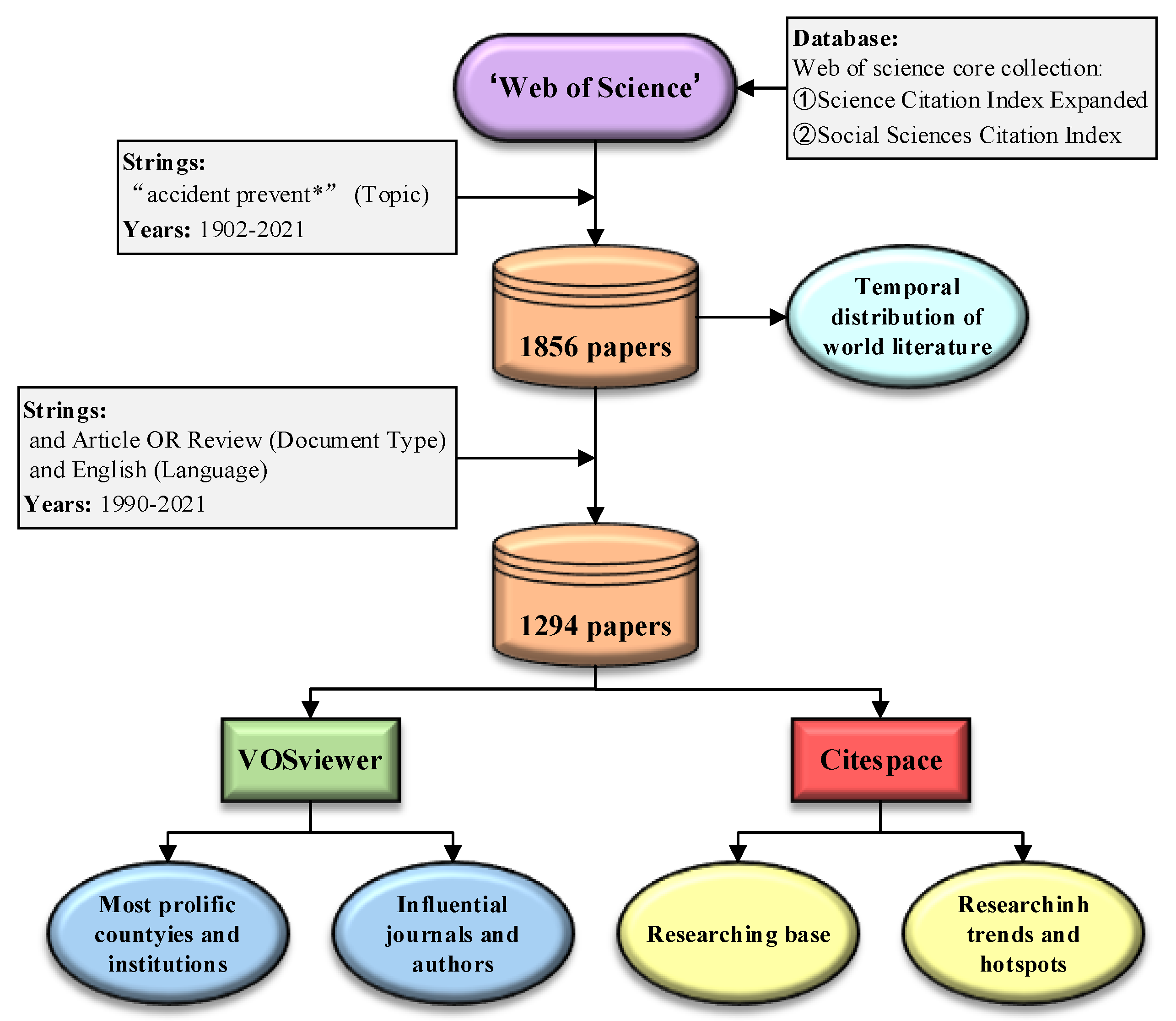
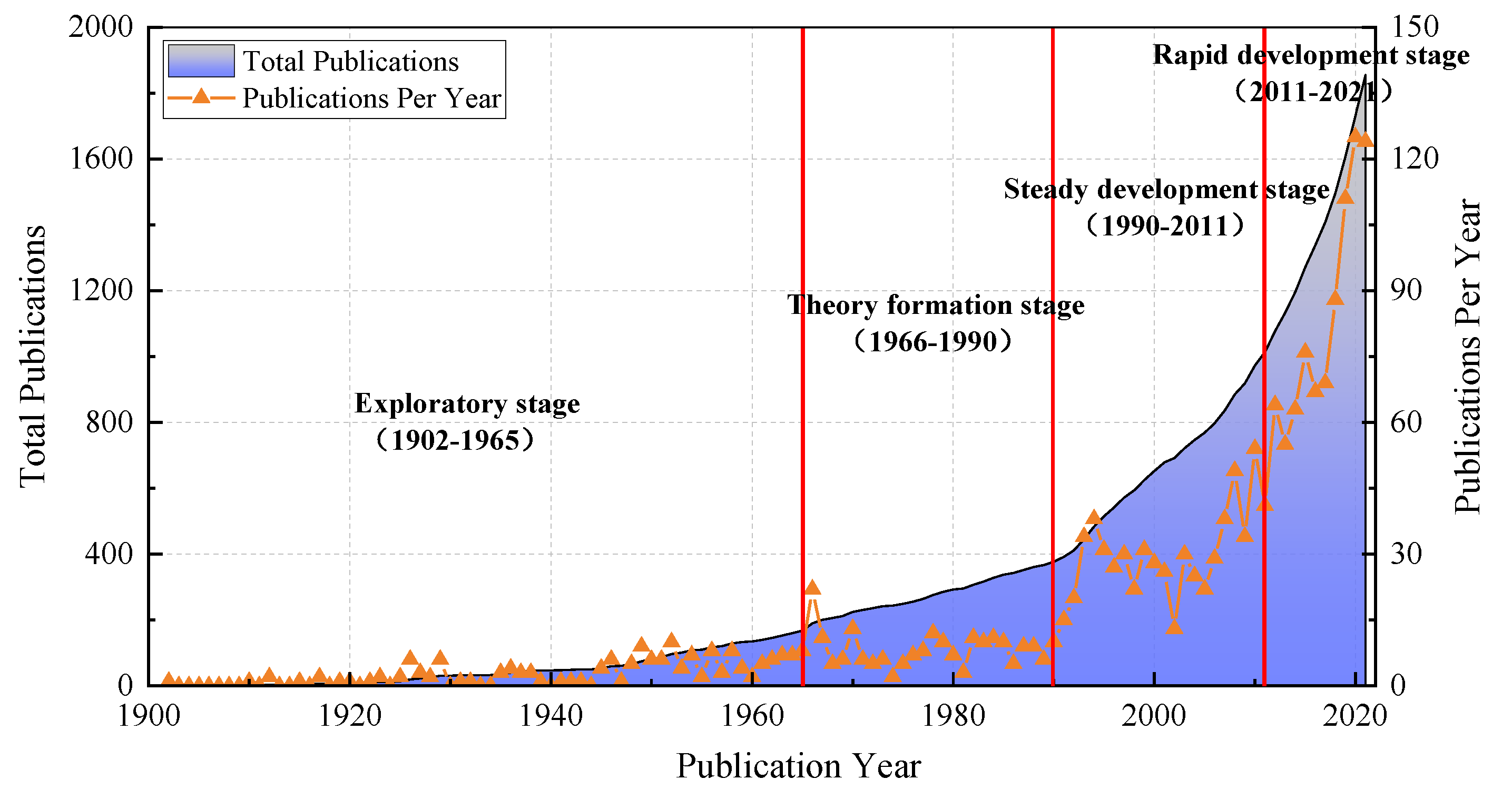
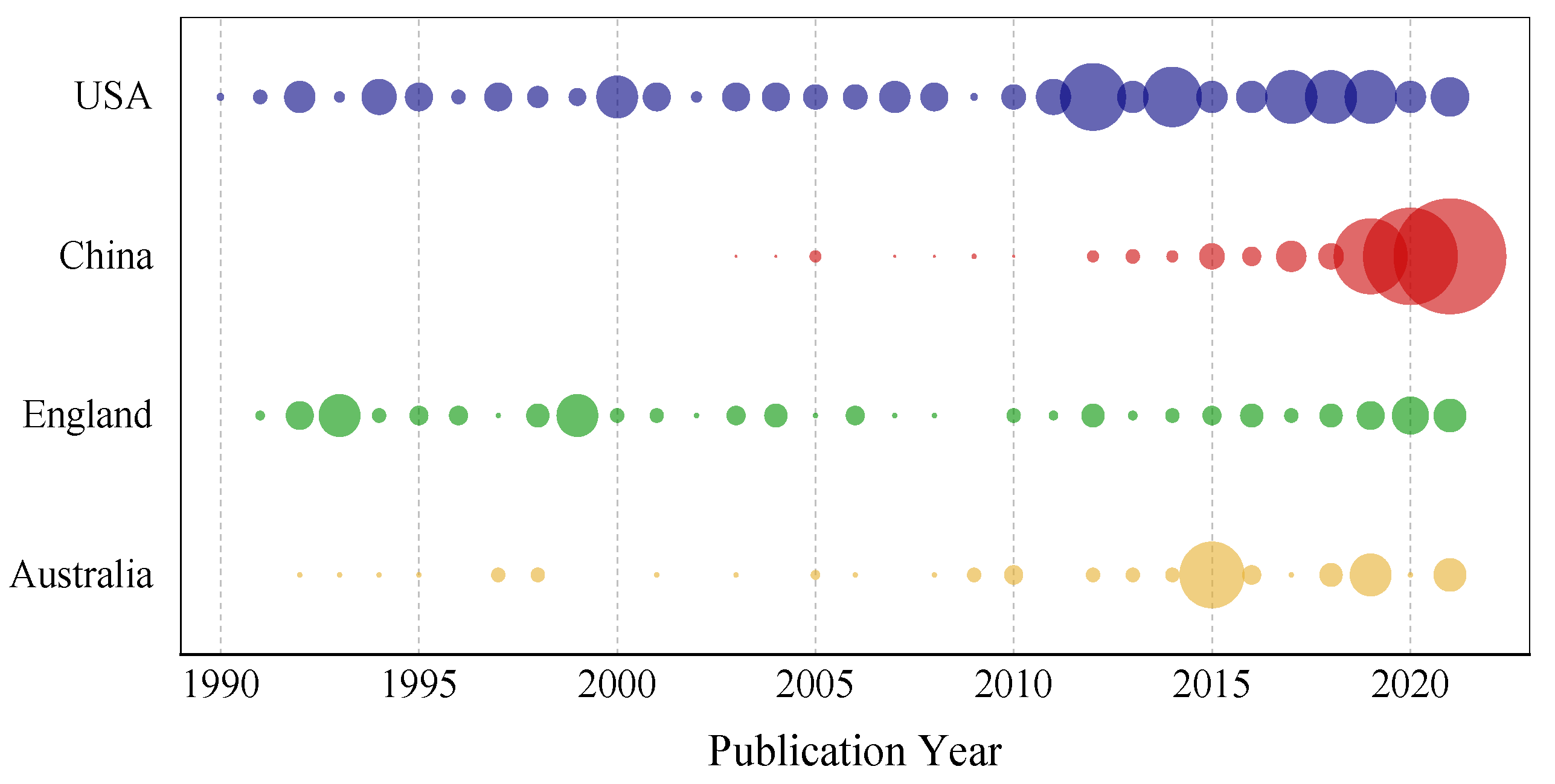
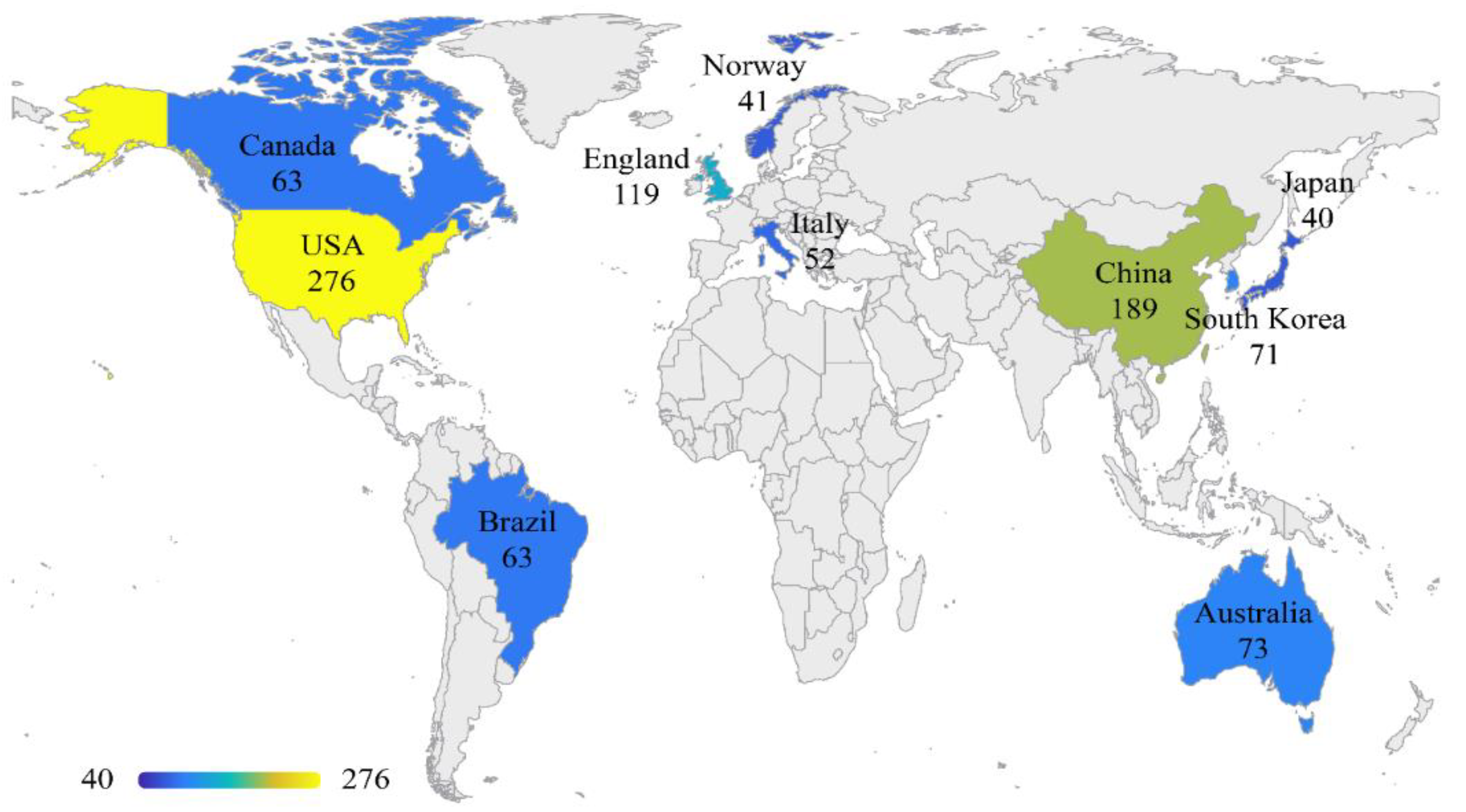
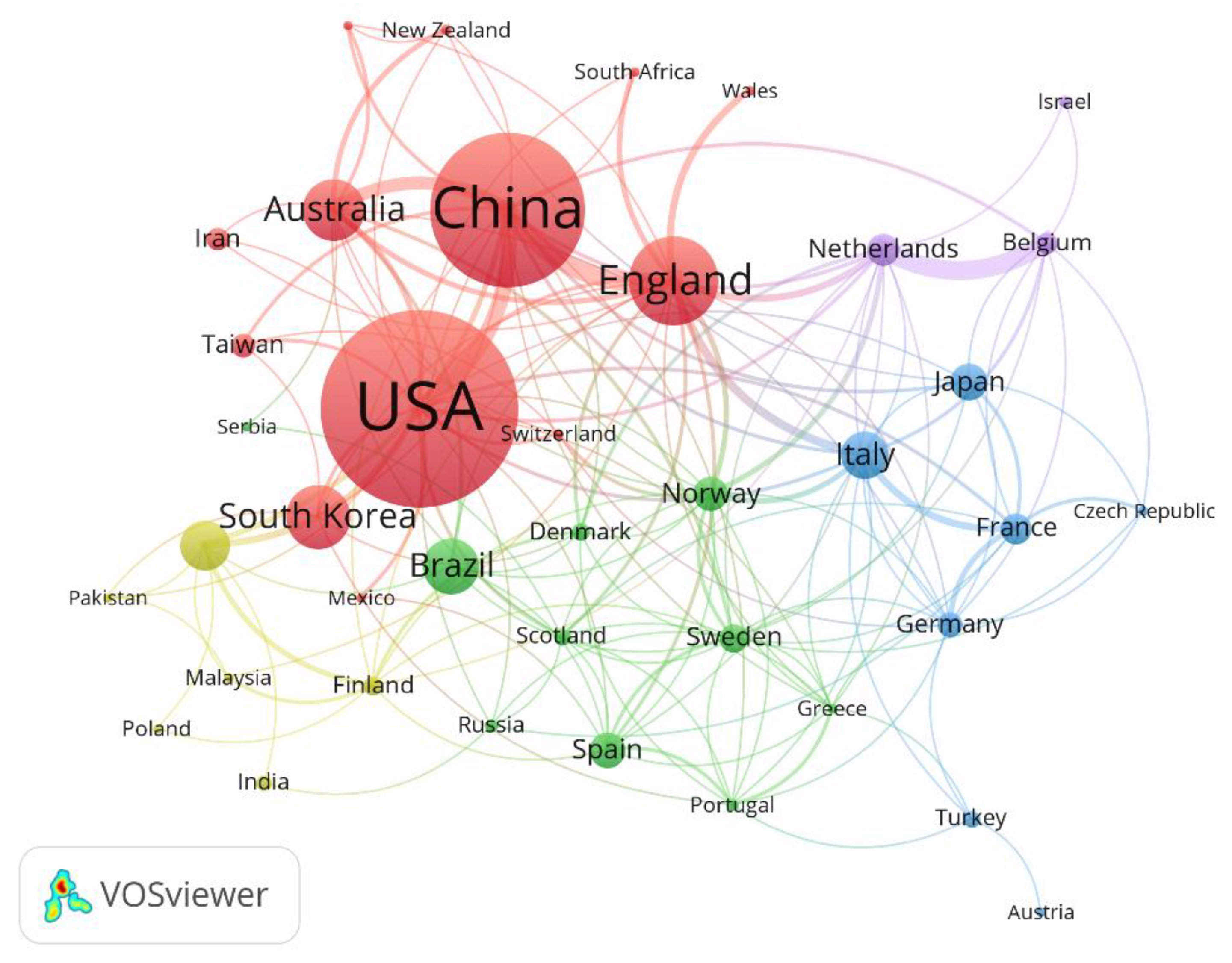
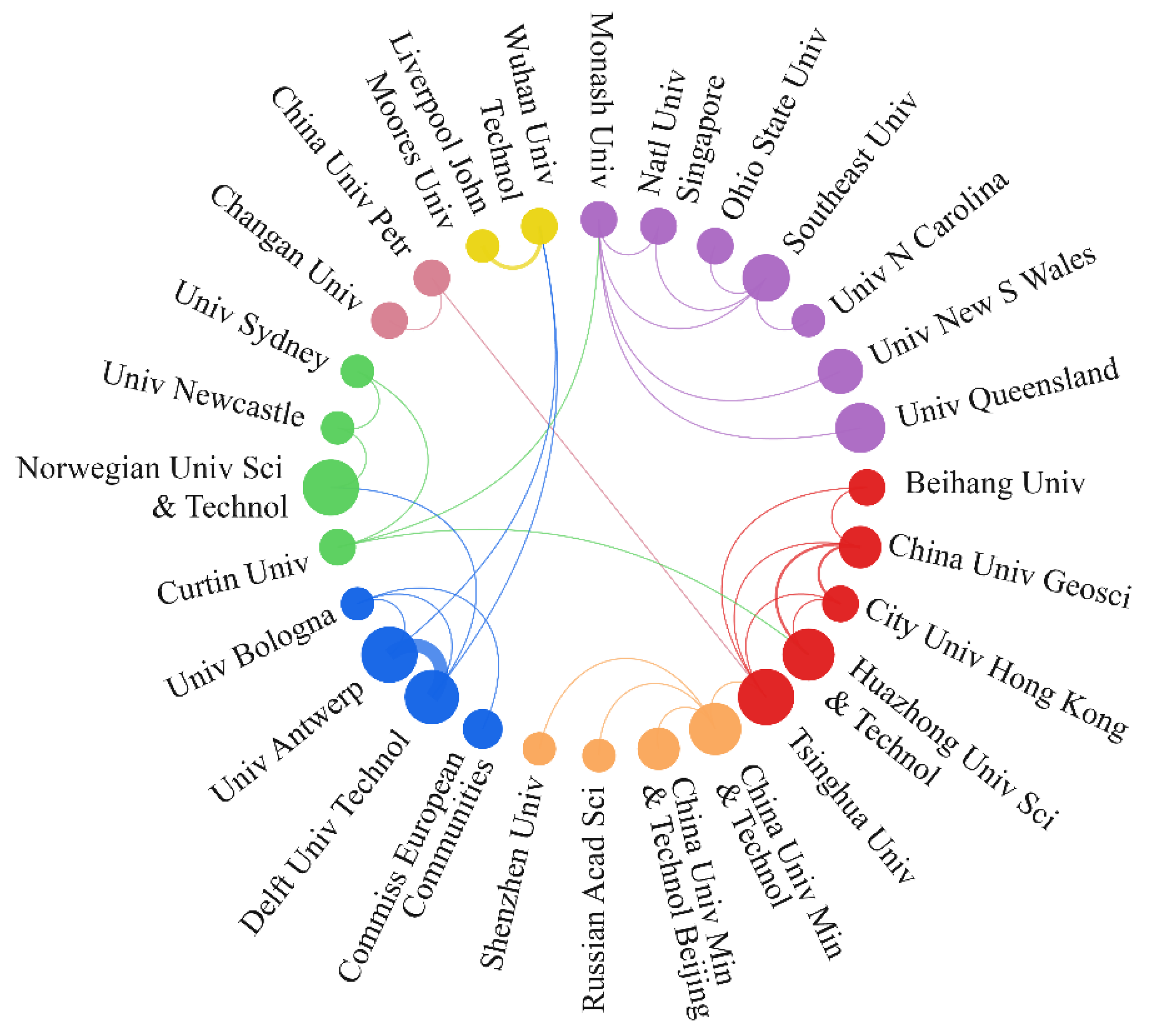
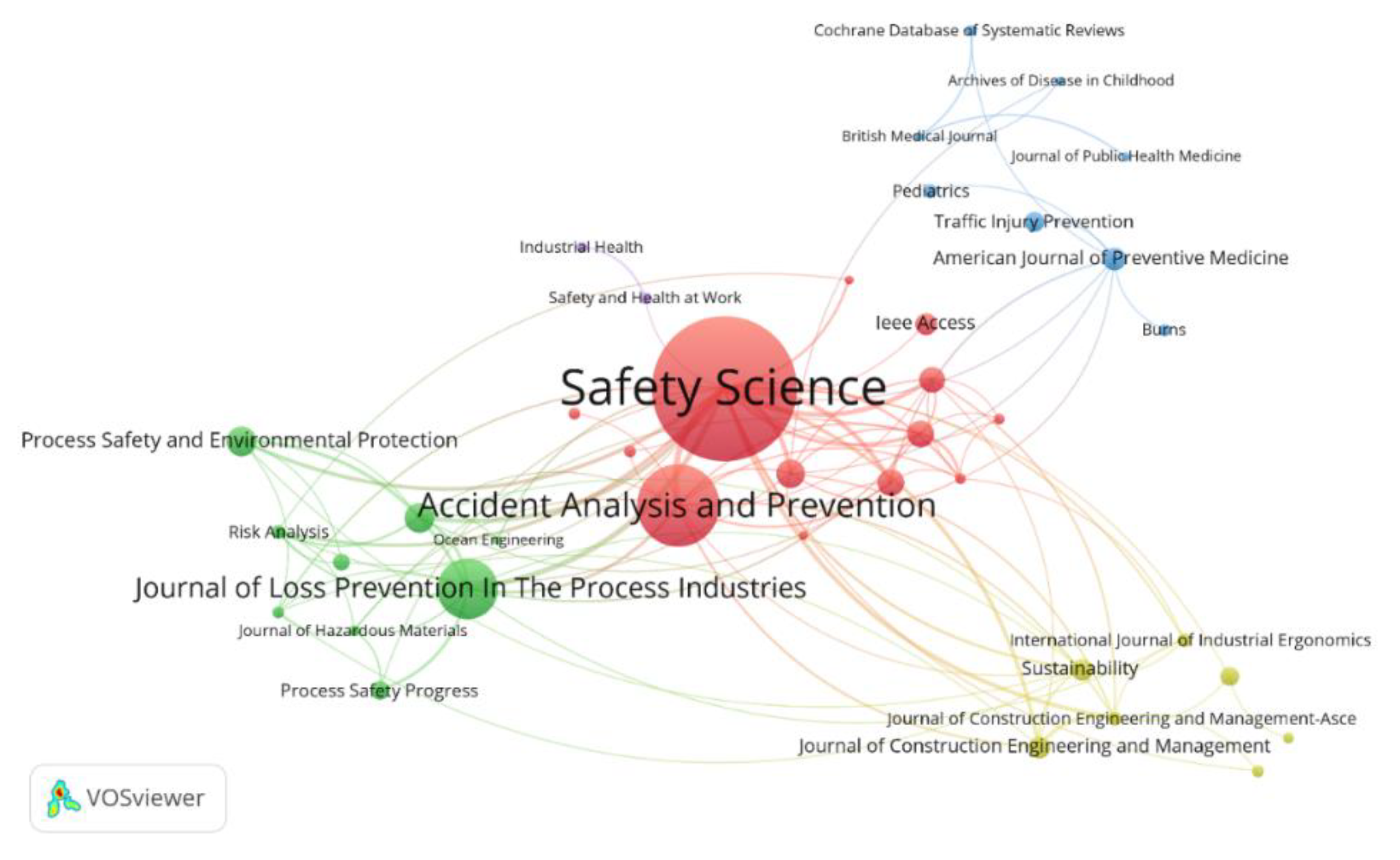
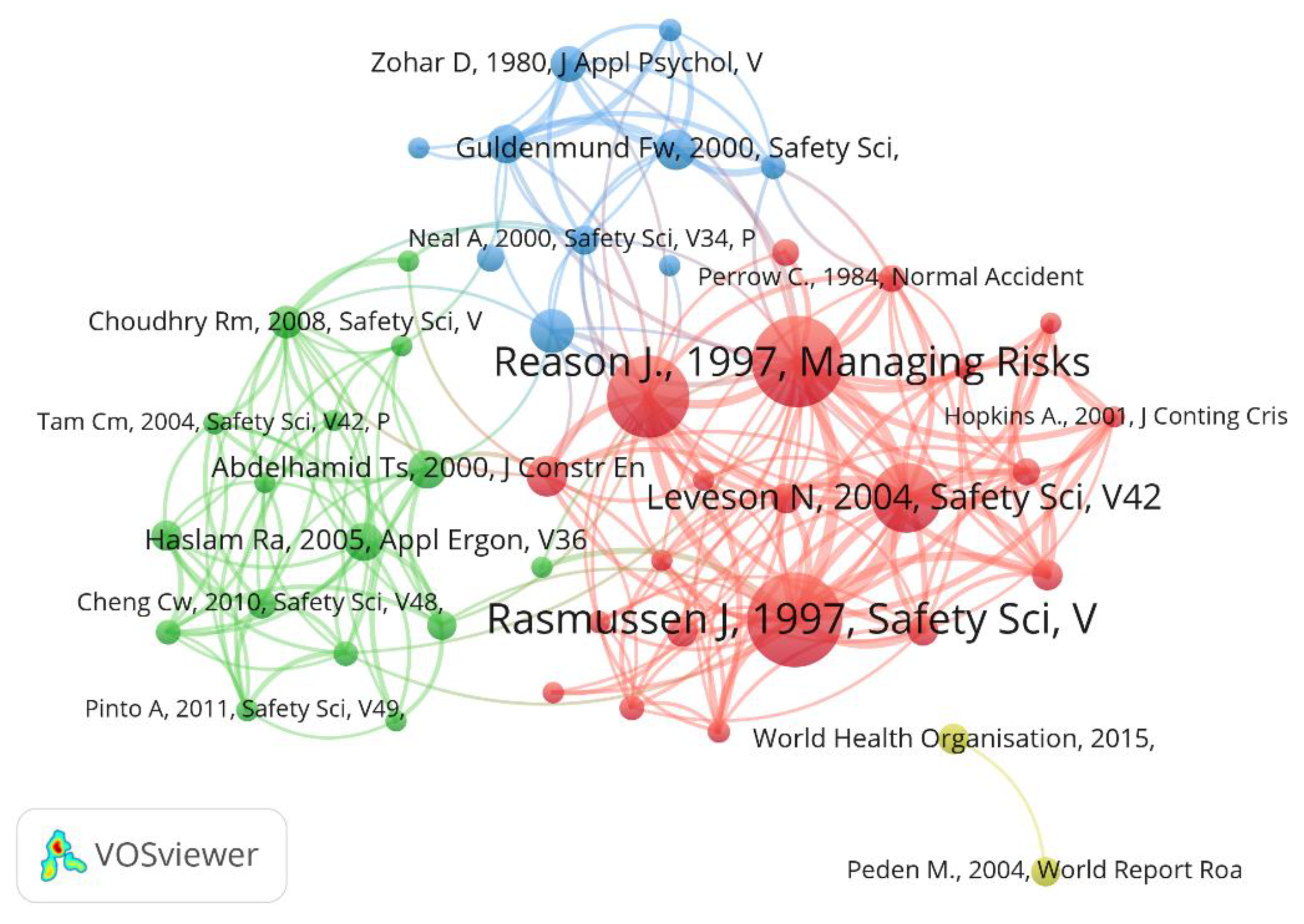
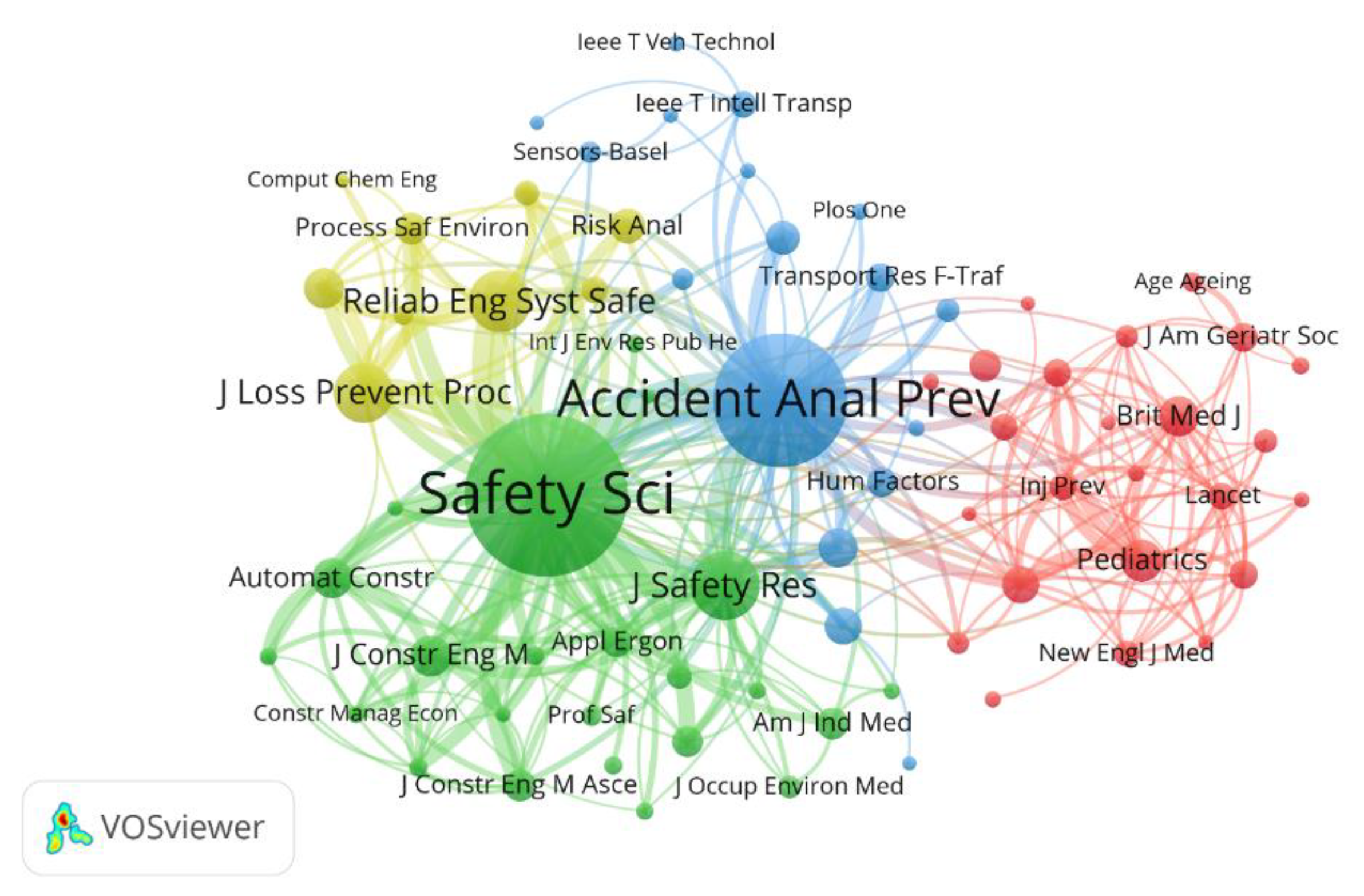
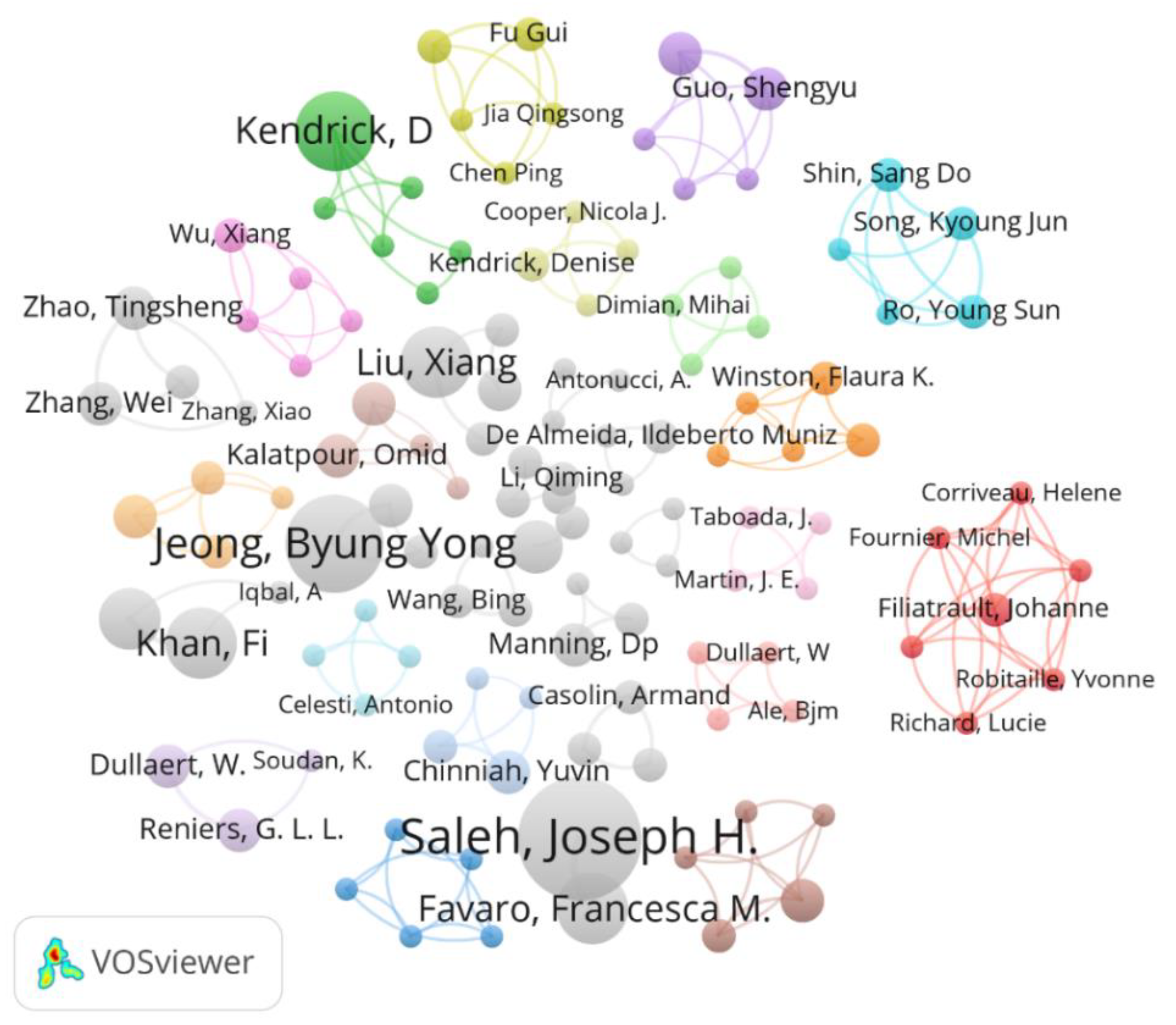
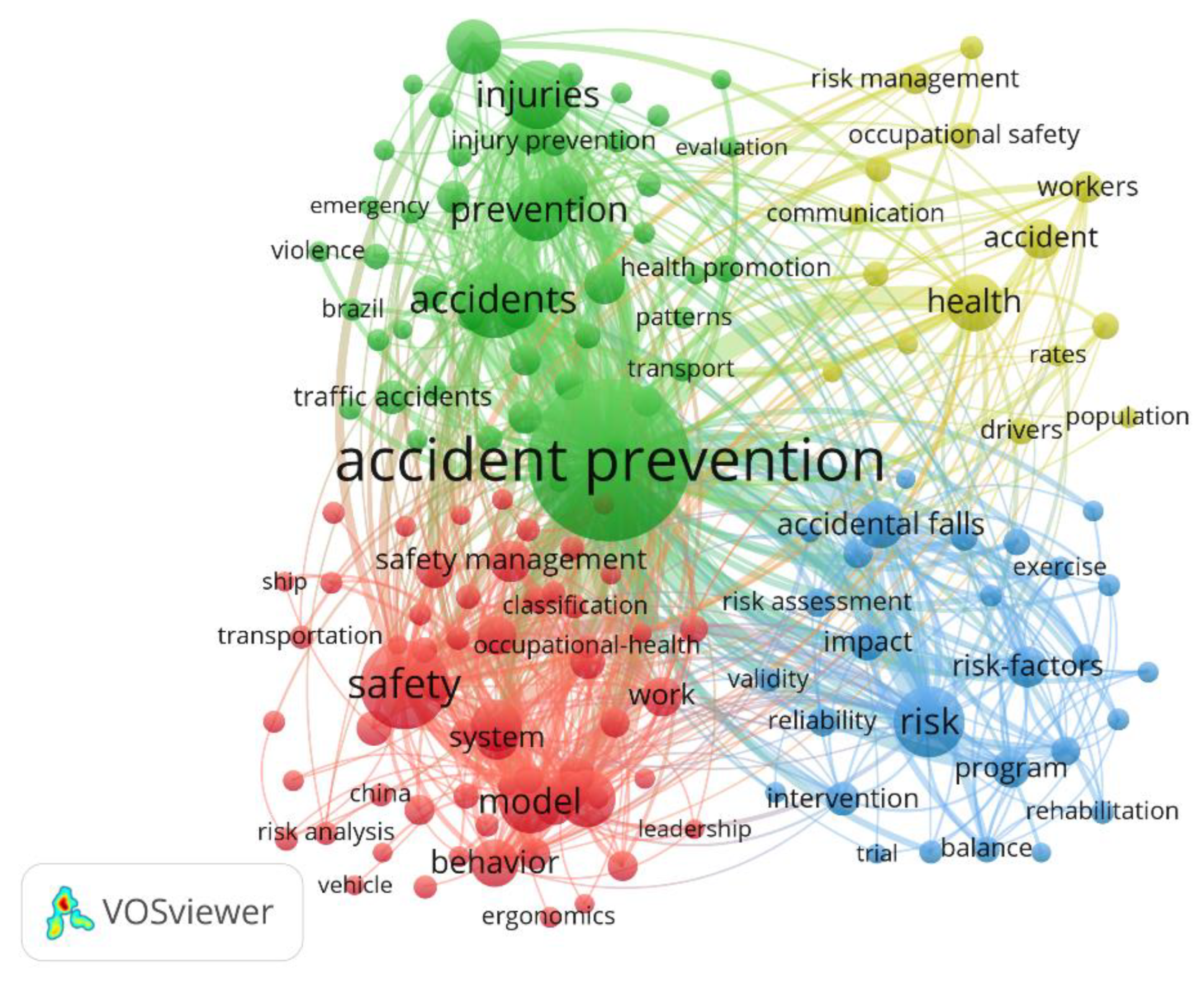
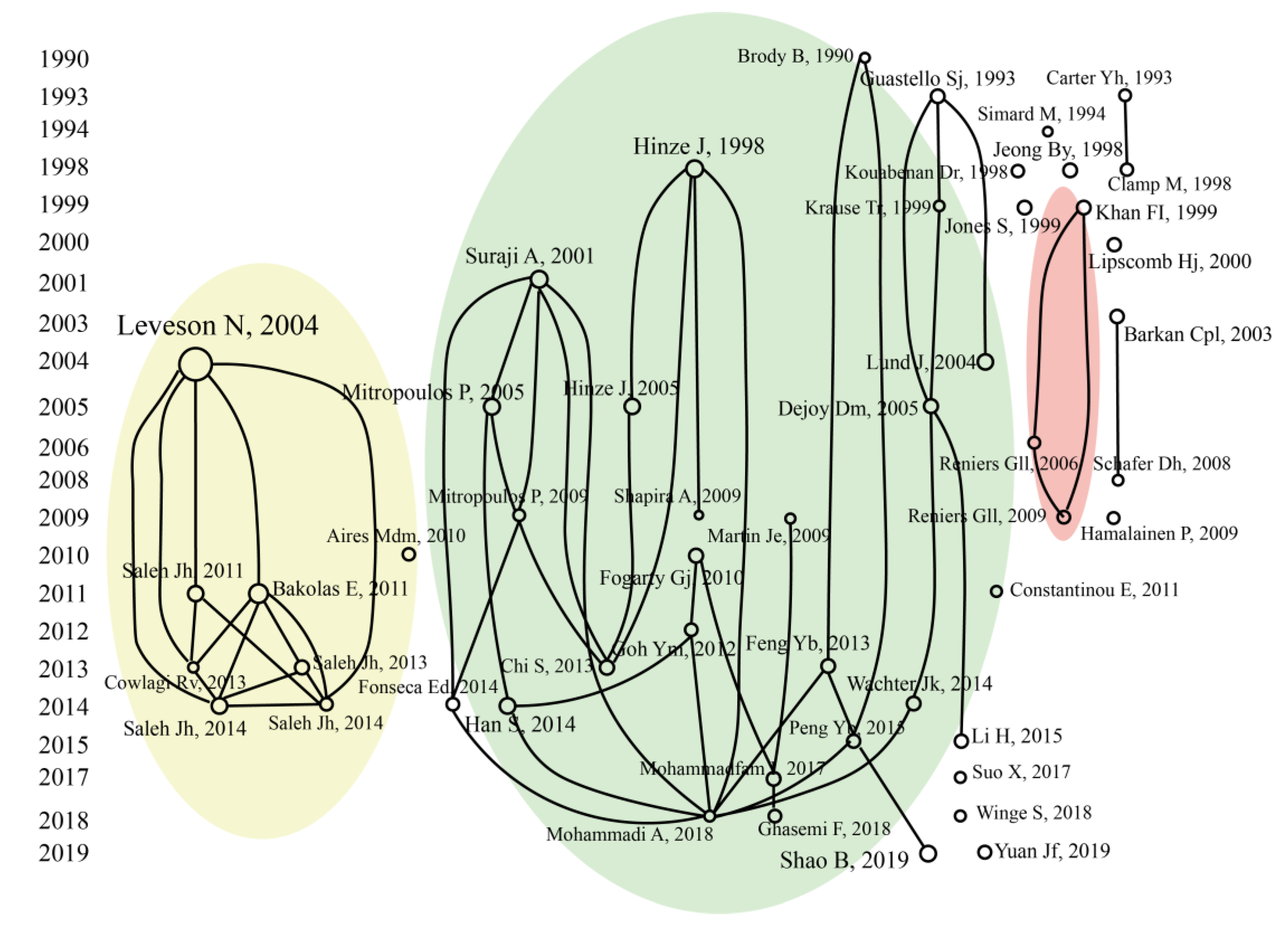
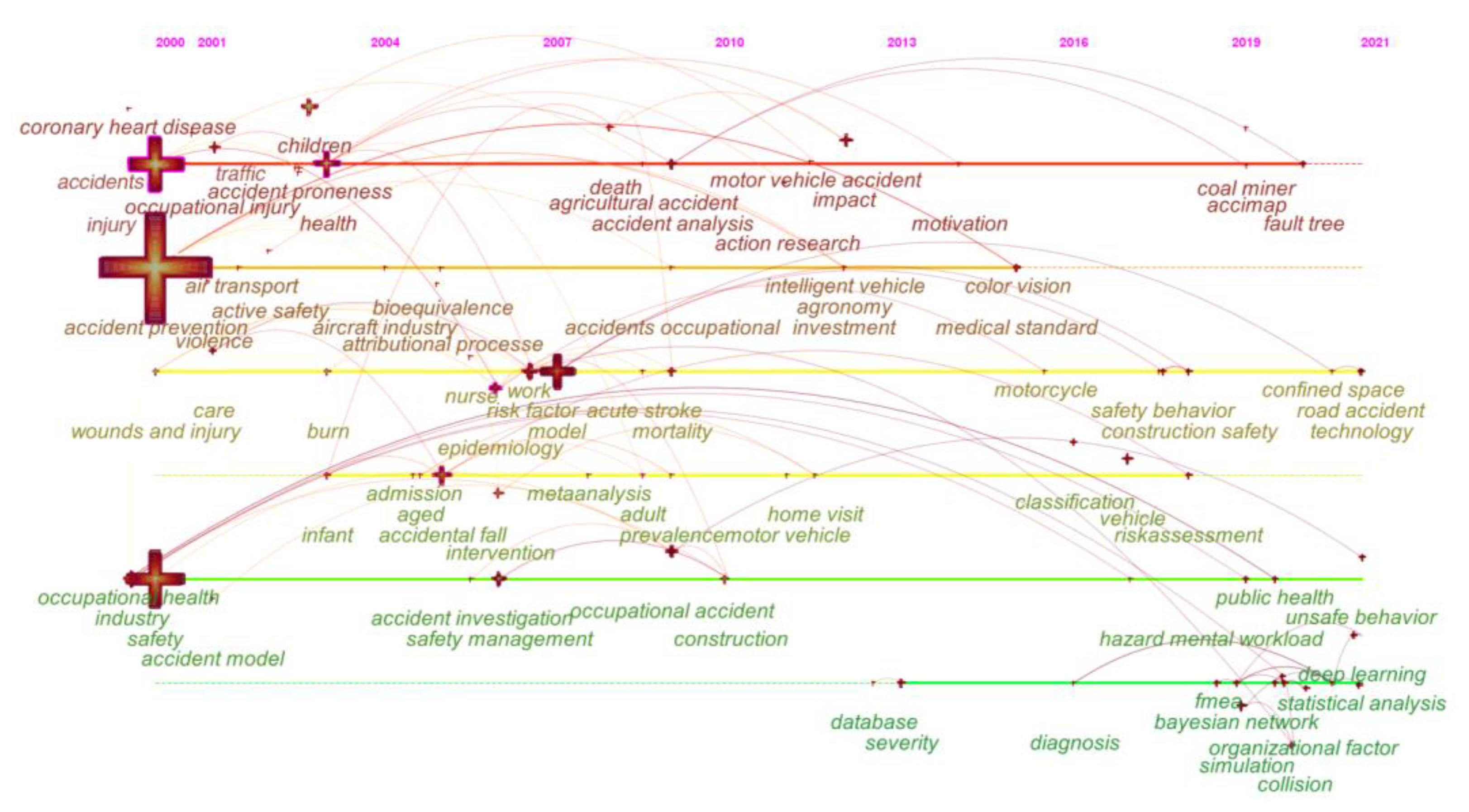
| NO. | Retrieval Strategies | Sample | Retrieval Quantity | Years | Sample Used in Each Section |
|---|---|---|---|---|---|
| 1 | Topic = (“prevention”) | A | 738,582 | 1902~2021 | Not used in analysis |
| 2 | Topic = (“accident”) | B | 69,290 | 1902~2021 | Not used in analysis |
| 3 | Topic = (“accident”) and Topic = (“prevention”) | A∩B | 5117 | 1902~2021 | Not used in analysis |
| 4 | Topic = (“accident prevent *”) | ~A, ~B | 1856 | 1902~2021 | Section 3.1.1 |
| 5 | Topic = (“accident prevent *”) | ~A, ~B | 1489 | 1990~2021 | Not used in analysis |
| 6 | Topic = (“accident prevent *”) and Document Types = (Article OR Review) and Language = (English) | ~A, ~B | 1294 | 1990~2021 | Section 3.1.2 Section 3.2, Section 3.3 and Section 3.4 |
| Rank | Country | Region | TP | Percentage | ACI | H-Index | Total Link Strength |
|---|---|---|---|---|---|---|---|
| 1 | USA | North America | 276 | 21.33% | 29.96 | 44 | 44 |
| 2 | China | Asia | 189 | 14.61% | 13.15 | 28 | 54 |
| 3 | UK | Europe | 119 | 9.20% | 28.38 | 30 | 50 |
| 4 | Australia | Oceania | 73 | 5.64% | 27.05 | 24 | 29 |
| 5 | South Korea | Asia | 71 | 5.49% | 9.93 | 12 | 8 |
| 6 | Brazil | South America | 63 | 4.87% | 7.67 | 11 | 8 |
| 7 | Canada | North America | 63 | 4.87% | 23.06 | 24 | 15 |
| 8 | Italy | Europe | 52 | 4.02% | 19.58 | 17 | 24 |
| 9 | Norway | Europe | 41 | 3.17% | 31.32 | 18 | 24 |
| 10 | Japan | Asia | 40 | 3.251 | 5.4 | 8 | 14 |
| Rank | TP | Centrality | WOS Categories | Percentage |
|---|---|---|---|---|
| 1 | 562 | 0 | Engineering | 43.43% |
| 2 | 294 | 0.12 | Public, environmental and occupational health | 22.72% |
| 3 | 185 | 0.16 | Engineering, industrial | 14.30% |
| 4 | 147 | 0.18 | Transportation | 11.36% |
| 5 | 143 | 0.02 | Operations research and management science | 11.05% |
| 6 | 127 | 0.39 | Ergonomics | 9.81% |
| 7 | 93 | 0.24 | Engineering and chemical | 7.19% |
| 8 | 85 | 0.37 | Social sciences | 6.57% |
| 9 | 84 | 0.04 | General and internal medicine | 6.49% |
| 10 | 83 | 0.08 | Engineering, civil | 6.41% |
| Rank | Institution | Country | TP | Total Link Strength | Sum of Times Cited | Average Citations |
|---|---|---|---|---|---|---|
| 1 | Georgia Inst Technol | USA | 15 | 0 | 413 | 27.53 |
| 2 | Norwegian Univ Sci & Technol | Norway | 14 | 1 | 484 | 34.57 |
| 3 | Tsinghua Univ | China | 14 | 5 | 204 | 14.57 |
| 4 | Univ Antwerp | Belgium | 14 | 11 | 374 | 26.71 |
| 5 | Univ Sao Paulo | Brazil | 14 | 1 | 84 | 6.00 |
| 6 | Delft Univ Technol | Netherland | 13 | 12 | 370 | 28.46 |
| 7 | China Univ Min & Technol | China | 12 | 2 | 71 | 5.92 |
| 8 | Huazhong Univ Sci & Technol | China | 12 | 4 | 169 | 14.08 |
| 9 | Univ Nottingham | UK | 12 | 0 | 363 | 30.25 |
| 10 | Hansung Univ | South Korea | 11 | 0 | 156 | 14.18 |
| Rank | Journal Title | TP | ACI | Citation Index | Impact Factor |
|---|---|---|---|---|---|
| 1 | Safety Science | 114 | 41.62 | SCIE | 4.877 |
| 2 | Accident Analysis and Prevention | 60 | 36.88 | SSCI | 4.993 |
| 3 | Journal of Loss Prevention in The Process Industries | 42 | 18.12 | SCIE | 3.66 |
| 4 | Process Safety and Environmental Protection | 19 | 31.74 | SCIE | 6.158 |
| 5 | Reliability Engineering & System Safety | 19 | 27.53 | SCIE | 6.188 |
| 6 | Journal of Safety Research | 18 | 37.72 | SSCI | 3.487 |
| 7 | International Journal of Environmental Research and Public Health | 17 | 7.24 | SCIE/SSCI | 3.39 |
| 8 | International Journal of Occupational Safety and Ergonomics | 17 | 14.76 | SSCI | 2.141 |
| 9 | Work-A Journal of Prevention Assessment & Rehabilitation | 16 | 4.25 | SSCI | 1.505 |
| 10 | American Journal of Public Health | 14 | 63.93 | SCIE/SSCI | 9.308 |
| Rank | Author | Country | Institute | TP | ACI | Main Research Interests |
|---|---|---|---|---|---|---|
| 1 | Saleh | USA | Georgia Inst Technol | 15 | 25.85 | Accident causation theory System reliability analysis |
| 2 | Jeong | South Korea | Hansung Univ | 11 | 5.50 | Occupational health and safety |
| 3 | Kendrick | UK | Univ Nottingham | 11 | 16.50 | Family and child health |
| 4 | Khan | Canada | Mem Univ Newfoundland | 8 | 25.71 | Probabilistic fault tree analysis Risk assessment |
| 5 | Kim | South Korea | Hanyang Univ | 8 | 19.86 | New energy research |
| 6 | Liu | USA | Rutgers State Univ | 8 | 11.86 | Analysis of traffic and transportation accidents |
| 7 | Abbasi | India | Pondicherry Univ | 7 | 1.50 | ORA (Optimal risk analysis) Maximum reliability accident analysis |
| 8 | Favaro | USA | San Jose State Univ | 7 | 20.71 | Security monitoring Risk assessment |
| 9 | Fu | China | China Univ Min & Technol Beijing | 7 | 29 | Coal mine, chemical cccident research |
| 10 | Reniers | Belgium | Univ Antwerp | 7 | 12.5 | Safety management Safety assessment |
| Rank | Keywords | Occurrences | Total Link Strength | Rank | Keywords | Occurrences | Total Link Strength |
|---|---|---|---|---|---|---|---|
| 1 | accident prevention | 489 | 1427 | 11 | Attitudes | 20 | 108 |
| 2 | accidents | 144 | 363 | 12 | care | 20 | 70 |
| 3 | behavior | 52 | 212 | 13 | construction safety | 20 | 69 |
| 4 | accidental falls | 44 | 209 | 14 | aged | 27 | 72 |
| 5 | children | 63 | 127 | 15 | balance | 14 | 77 |
| 6 | climate | 32 | 180 | 16 | burns | 14 | 47 |
| 7 | accident analysis | 28 | 80 | 17 | classification | 14 | 58 |
| 8 | culture | 27 | 135 | 18 | Bayesian network | 12 | 47 |
| 9 | construction | 25 | 123 | 19 | causation | 12 | 48 |
| 10 | crashes | 21 | 82 | 20 | construction industry | 12 | 41 |
| Rank | Title | Journal | Type | Authors | Year | STC | IN | CN |
|---|---|---|---|---|---|---|---|---|
| 1 | A new accident model for engineering safer systems [47] | Safety Science | Article | Leveson | 2004 | 990 | 1 | 1 |
| 2 | Reviews of evidence regarding interventions to reduce alcohol-impaired driving [76] | American Journal of Preventive Medicine | Review | Shults et al. | 2001 | 441 | 4 | 1 |
| 3 | A review of hazards associated with primary lithium and lithium-ion batteries [77] | Process Safety and Environmental Protection | Article | Lisbona | 2011 | 323 | 1 | 1 |
| 4 | Effects of exercise programs on falls and mobility in frail and pre-frail older adults: a multicenter randomized controlled trial [78] | Archives of Physical Medicine and Rehabilitation | Article | Faber et al. | 2006 | 299 | 2 | 1 |
| 5 | Cerebral palsy [79] | Lancet | Article | Colver et al. | 2014 | 239 | 4 | 1 |
| 6 | The epidemiology of fractures in children [80] | Injury-International Journal of The Care of The Injured | Article | Rennie et al. | 2007 | 227 | 1 | 1 |
| 7 | Development of causal model of construction accident causation [59] | Journal of Construction Engineering and Management-Asce | Article | Suraji et al. | 2001 | 204 | 2 | 2 |
| 8 | A cross-validation of safety climate scale using confirmatory factor analytic approach [81] | Journal of Safety Research | Article | Seo, et al. | 2004 | 182 | 1 | 1 |
| 9 | Risky and aggressive driving in young adults: Personality matters [82] | Accident Analysis and Prevention | Article | Constantinou et al. | 2011 | 178 | 1 | 1 |
| 10 | Oil spill problems and sustainable response strategies through new technologies [83] | Environmental Science-Processes & Impacts | Review | Ivshina, IB et al. | 2015 | 173 | 6 | 4 |
| 11 | Systems model of construction accident causation [84] | Journal of Construction Engineering and Management | Article | Mitropoulos et al. | 2005 | 173 | 1 | 1 |
| 12 | Behavior change versus culture change: Divergent approaches to managing workplace safety [9] | Safety Science | Article | DeJoy | 2005 | 171 | 1 | 1 |
| 13 | Associations between risk perception and safety [85] | Safety Science | Article | Rundmo | 1996 | 169 | 1 | 1 |
| 14 | Influence of long-term orotracheal or nasotracheal intubation on nosocomial maxillary sinusitis and pneumonia-results of a prospective, randomized, clinical-trial, clinical-trial [86] | Critical Care Medicine | Article | Holzapfel et al. | 1993 | 169 | 3 | 1 |
| 15 | Sleep problems and work injuries: A systematic review and meta-analysis [87] | Sleep Medicine Reviews | Review | Uehli et al. | 2014 | 165 | 3 | 2 |
| Keywords | Year | Strength | Begin | End | 2000–2021 |
|---|---|---|---|---|---|
| prevention | 2000 | 6.13 | 2003 | 2009 | ▂▂▂▃▃▃▃▃▃▃▂▂▂▂▂▂▂▂▂▂▂▂ |
| intervention | 2000 | 5.32 | 2006 | 2015 | ▂▂▂▂▂▂▃▃▃▃▃▃▃▃▃▃▂▂▂▂▂▂ |
| risk factor | 2000 | 4.12 | 2009 | 2010 | ▂▂▂▂▂▂▂▂▂▃▃▂▂▂▂▂▂▂▂▂▂▂ |
| fatality | 2000 | 5.11 | 2015 | 2017 | ▂▂▂▂▂▂▂▂▂▂▂▂▂▂▂▃▃▃▂▂▂▂ |
| risk management | 2000 | 7.47 | 2016 | 2019 | ▂▂▂▂▂▂▂▂▂▂▂▂▂▂▂▂▃▃▃▃▂▂ |
| occupational injury | 2000 | 4.98 | 2016 | 2018 | ▂▂▂▂▂▂▂▂▂▂▂▂▂▂▂▂▃▃▃▂▂▂ |
| system | 2000 | 8.92 | 2018 | 2021 | ▂▂▂▂▂▂▂▂▂▂▂▂▂▂▂▂▂▂▃▃▃▃ |
| safety management | 2000 | 5.64 | 2019 | 2021 | ▂▂▂▂▂▂▂▂▂▂▂▂▂▂▂▂▂▂▂▃▃▃ |
| simulation | 2000 | 4.97 | 2019 | 2021 | ▂▂▂▂▂▂▂▂▂▂▂▂▂▂▂▂▂▂▂▃▃▃ |
| Bayesian network | 2000 | 3.72 | 2019 | 2021 | ▂▂▂▂▂▂▂▂▂▂▂▂▂▂▂▂▂▂▂▃▃▃ |
Publisher’s Note: MDPI stays neutral with regard to jurisdictional claims in published maps and institutional affiliations. |
© 2022 by the authors. Licensee MDPI, Basel, Switzerland. This article is an open access article distributed under the terms and conditions of the Creative Commons Attribution (CC BY) license (https://creativecommons.org/licenses/by/4.0/).
Share and Cite
Huang, R.; Liu, H.; Ma, H.; Qiang, Y.; Pan, K.; Gou, X.; Wang, X.; Ye, D.; Wang, H.; Glowacz, A. Accident Prevention Analysis: Exploring the Intellectual Structure of a Research Field. Sustainability 2022, 14, 8784. https://doi.org/10.3390/su14148784
Huang R, Liu H, Ma H, Qiang Y, Pan K, Gou X, Wang X, Ye D, Wang H, Glowacz A. Accident Prevention Analysis: Exploring the Intellectual Structure of a Research Field. Sustainability. 2022; 14(14):8784. https://doi.org/10.3390/su14148784
Chicago/Turabian StyleHuang, Rui, Hui Liu, Hongliang Ma, Yujie Qiang, Kai Pan, Xiaoqing Gou, Xin Wang, Dong Ye, Haining Wang, and Adam Glowacz. 2022. "Accident Prevention Analysis: Exploring the Intellectual Structure of a Research Field" Sustainability 14, no. 14: 8784. https://doi.org/10.3390/su14148784
APA StyleHuang, R., Liu, H., Ma, H., Qiang, Y., Pan, K., Gou, X., Wang, X., Ye, D., Wang, H., & Glowacz, A. (2022). Accident Prevention Analysis: Exploring the Intellectual Structure of a Research Field. Sustainability, 14(14), 8784. https://doi.org/10.3390/su14148784







